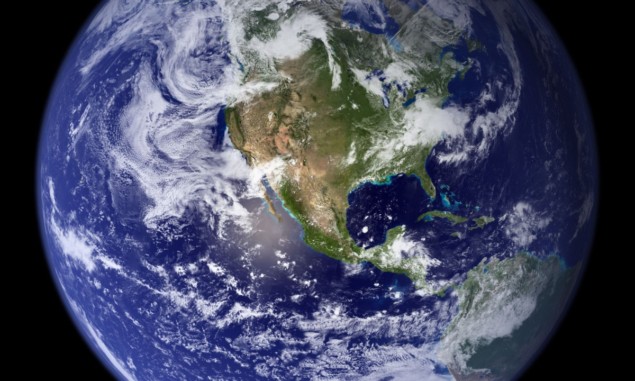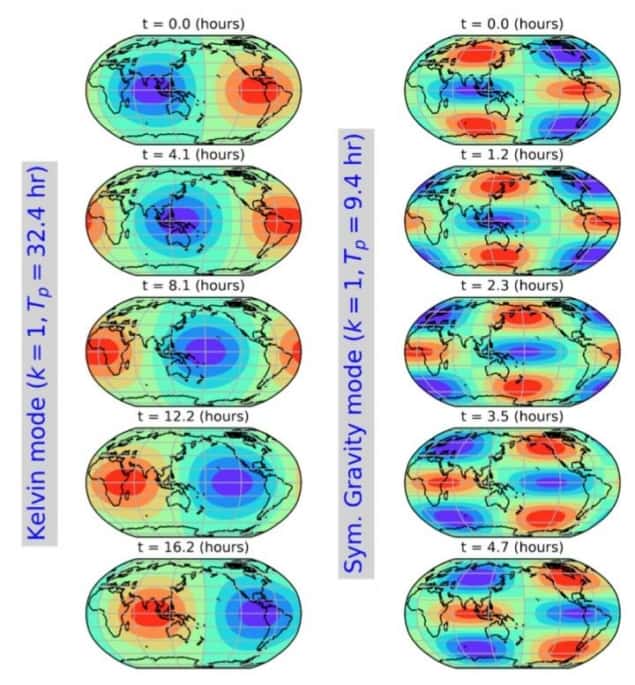
The Earth’s entire atmosphere vibrates like a giant bell, with various large-scale resonant waves travelling in both directions around the globe. That is the conclusion of scientists in Japan and the US, who have confirmed a nearly two-centuries-old hypothesis of atmospheric resonance. Their research should help improve both weather forecasts and long-term climate forecasts.
The fundamentals of atmospheric resonance were first laid out in the early 1800s by the French scholar and mathematician Pierre-Simon Laplace. “Laplace showed that amidst all the complications of the atmospheric dynamics there should be a set of wave motions with energy content trapped in the vertical – i.e. trapped against the earth’s surface –and propagating purely in the horizontal,’ explains atmospheric scientist Kevin Hamilton of the University of Hawaiʻi at Mānoa.
He adds, Laplace predicted “that the horizontal properties of these waves should be the same as for a uniformly deep ocean covering the whole earth with some ‘equivalent depth’.” The nature of this horizontal structure is governed by Laplace’s tidal equation.
Researchers have been able to readily identify the forced waves associated with the rotation of the Earth – atmospheric thermal tides – also predicted as a result of Laplace’s initial work. However, despite considerable subsequent work, their presence of Laplace’s waves had remained undetected.
Observational gap
This is because the waves have both very large horizontal scales and short periods of a day or less, which puts them into an observational gap between studies of small-scale phenomena operating over small timescales (like individual thunderstorms, for example) and larger-scale features with periods of a day or more.

In their new study, however, Hamilton and colleague Takatoshi Sakazaki — a physicist from Japan’s Kyoto University – have used re-analysis data from the European Centre for Medium Range Weather Forecasts to examine atmospheric pressure across the globe on an hourly basis from 1979–2016. The team’s examination of surface pressure values from the new data set revealed dozens of the predicted normal wave modes, typically with periods between two and thirty-three hours that travel horizontally around the globe at speeds in excess of 1100 km/h. The team found that the propagation of these waves results in a checkerboard-style pattern of high and low pressure that encircles the globe.
“For these rapidly moving wave modes, our observed frequencies and global patterns match those theoretically predicted very well,” said Sakazaki. “It is exciting to see the vision of Laplace and other pioneering physicists so completely validated after two centuries.”
New avenue of research
“Our identification of so many modes in real data shows that the atmosphere is indeed ringing like a bell,” agreed Hamilton. “This finally resolves a longstanding and classic issue in atmospheric science, but it also opens a new avenue of research to understand both the processes that excite the waves and those that act to damp the waves.”
According to Hamilton, possible drivers of the resonant waves may include a global effect of far small-scale latent heating in the atmosphere from convection, or excitation through part of the turbulent cascades of energy through the atmosphere.
“As an analogy, imagine a bathtub full of water. Take a paddle and vigorously stir for a few seconds. Wait for a minute and see how the flow develops,” he explains. “You will see small scale motions as a result of the turbulent interactions, but you will also notice a more organized sloshing on the bathtub-wide scale at the natural resonance frequencies.”
Global climate models
With their initial study complete, the researchers are now looking to undertake comparisons between their findings and the outputs of global climate models.
The findings are “a beautiful example of fundamental theory confirmed in observations – something not very common in a complex system like the Earth’s atmosphere,” comments Ted Shepherd, a climate scientist at the University of Reading in the UK.

Atmospheric rivers drive local sea-level rise
“There have been recent developments advocating for renewed attention to these modes as a diagnostic of atmospheric behaviour,” he added. “This new study shows how surface pressure observations have the potential to unlock that opportunity.”
“The normal modes detected now could prove useful to test models of Earth’s circulation,” agreed Stephen Lewis, an atmospheric physicist from the UK’s Open University. In addition, he added, the wave modes “even have connections to modes that could play a role in the thinner atmosphere of Mars.”
The research is described in the Journal of Atmospheric Sciences.



